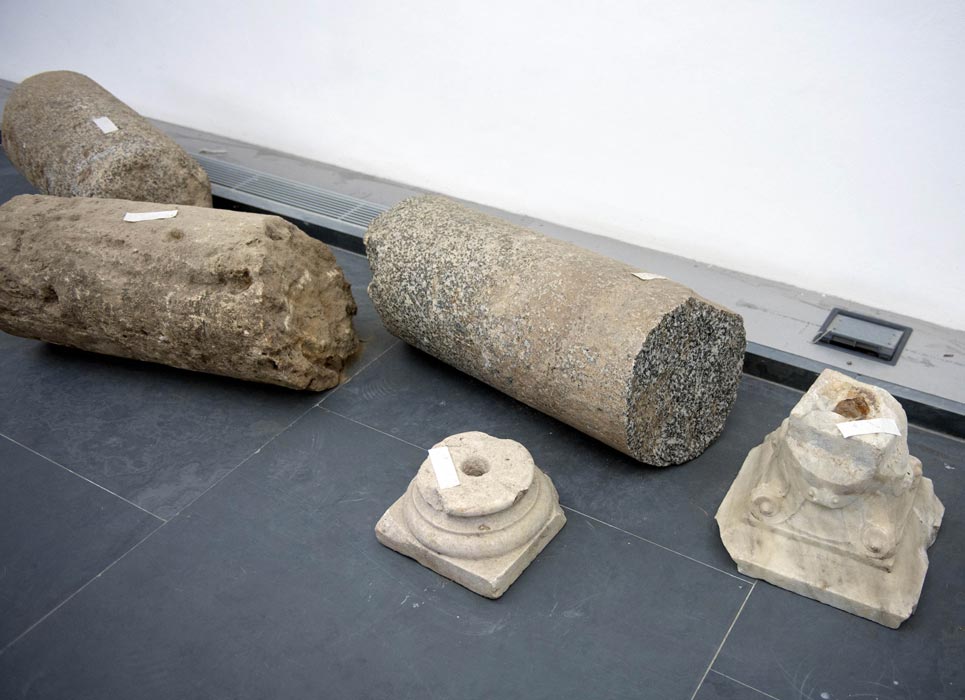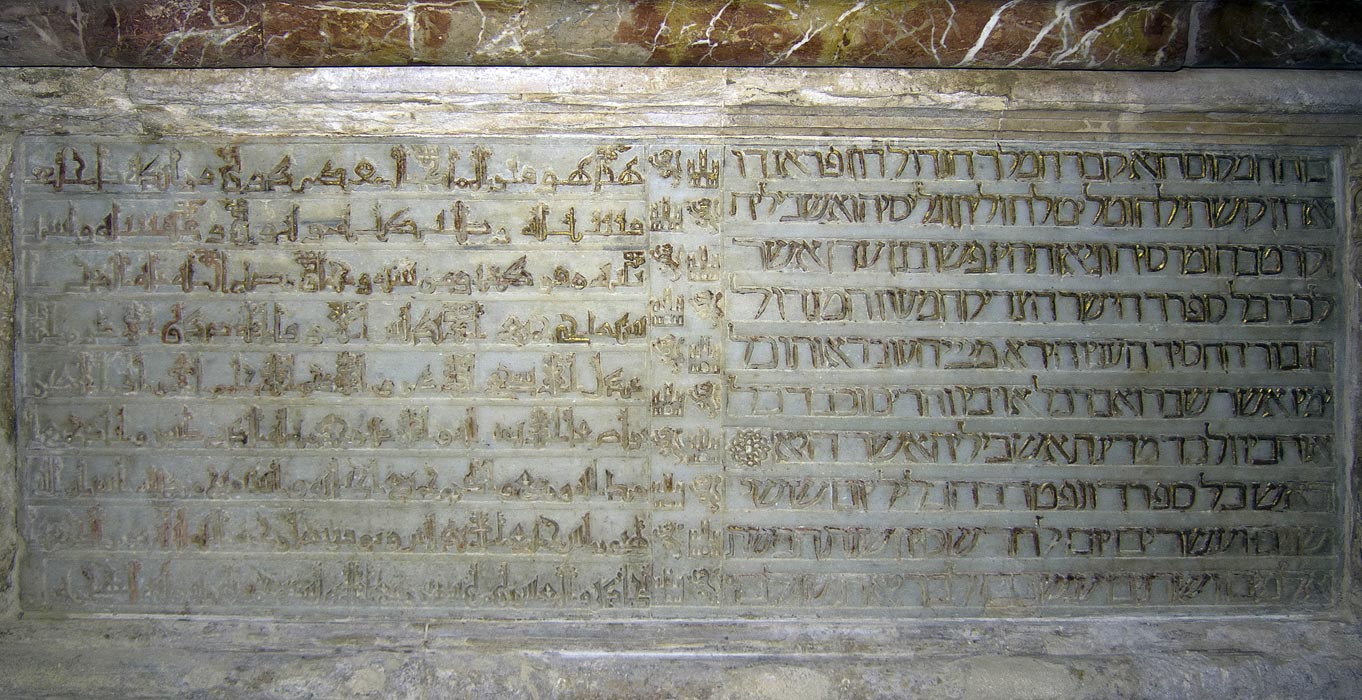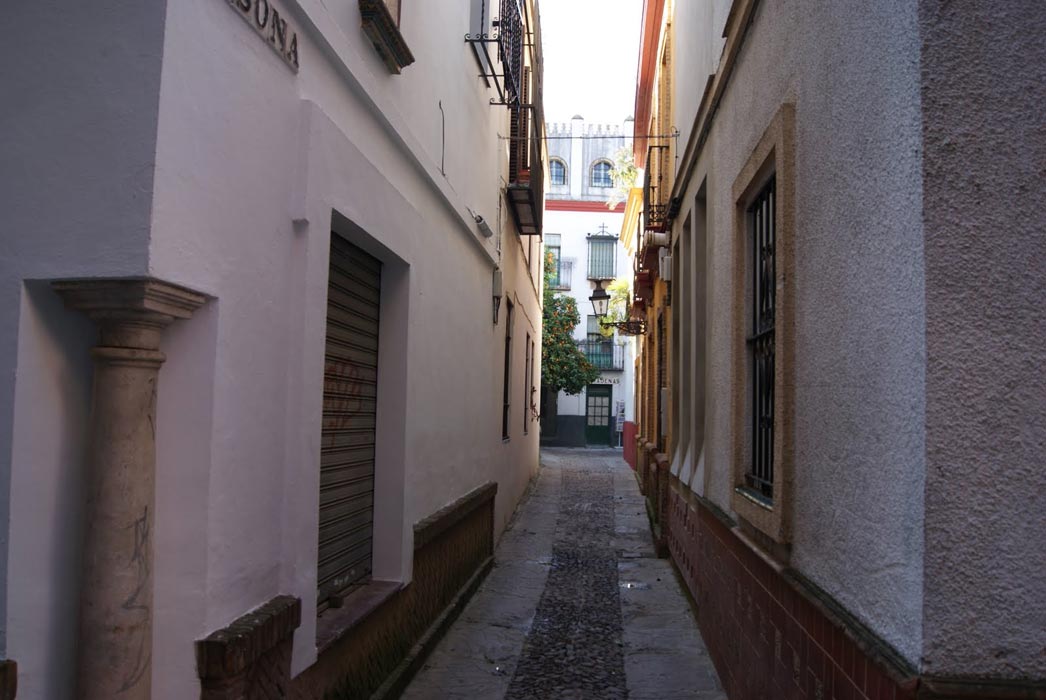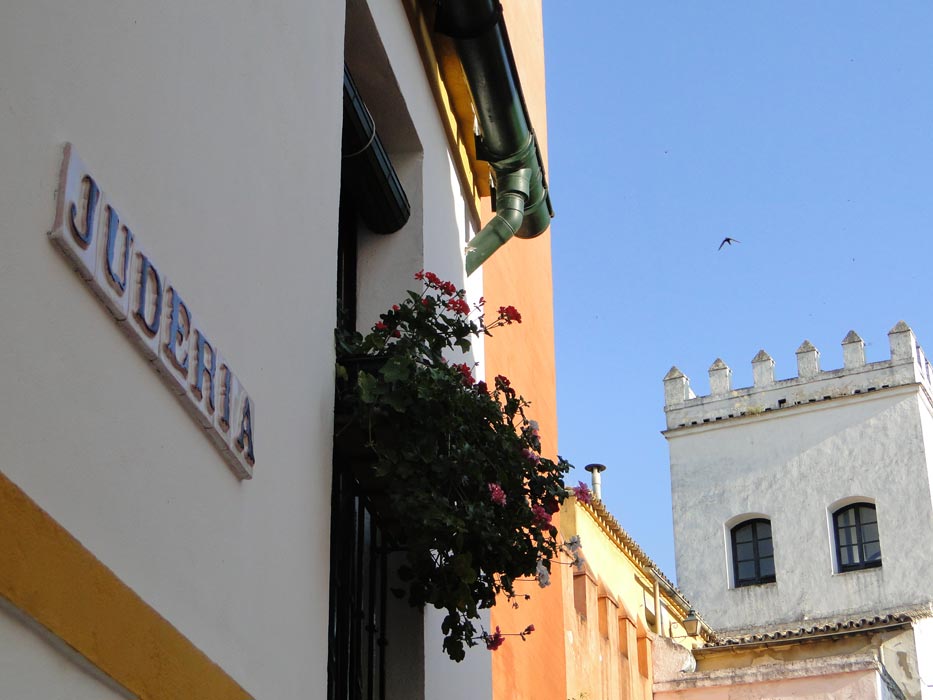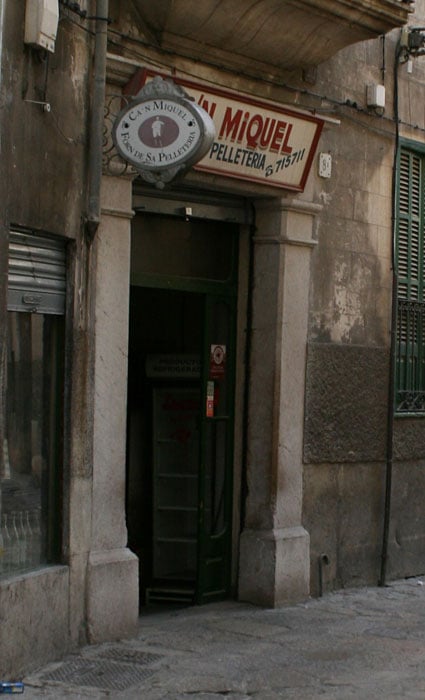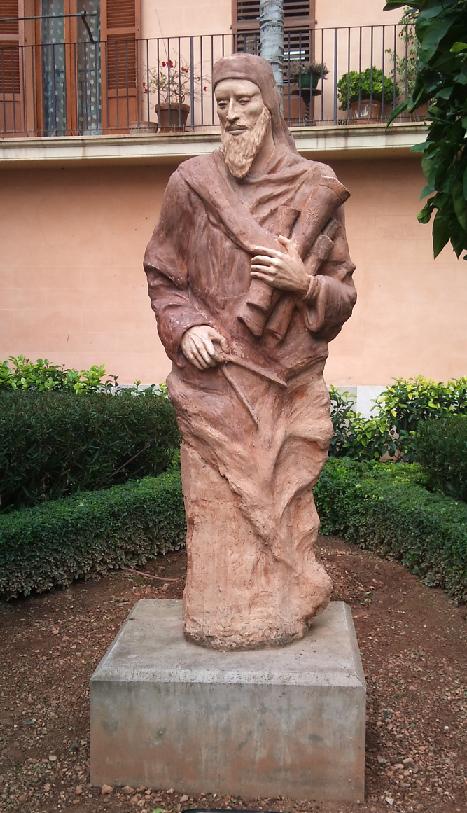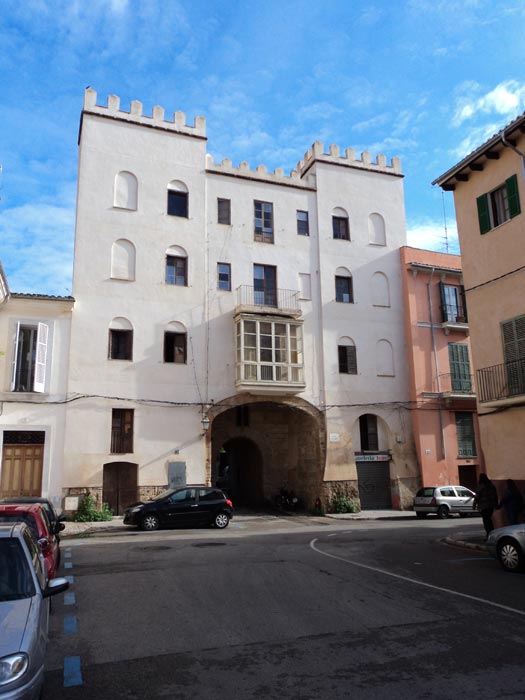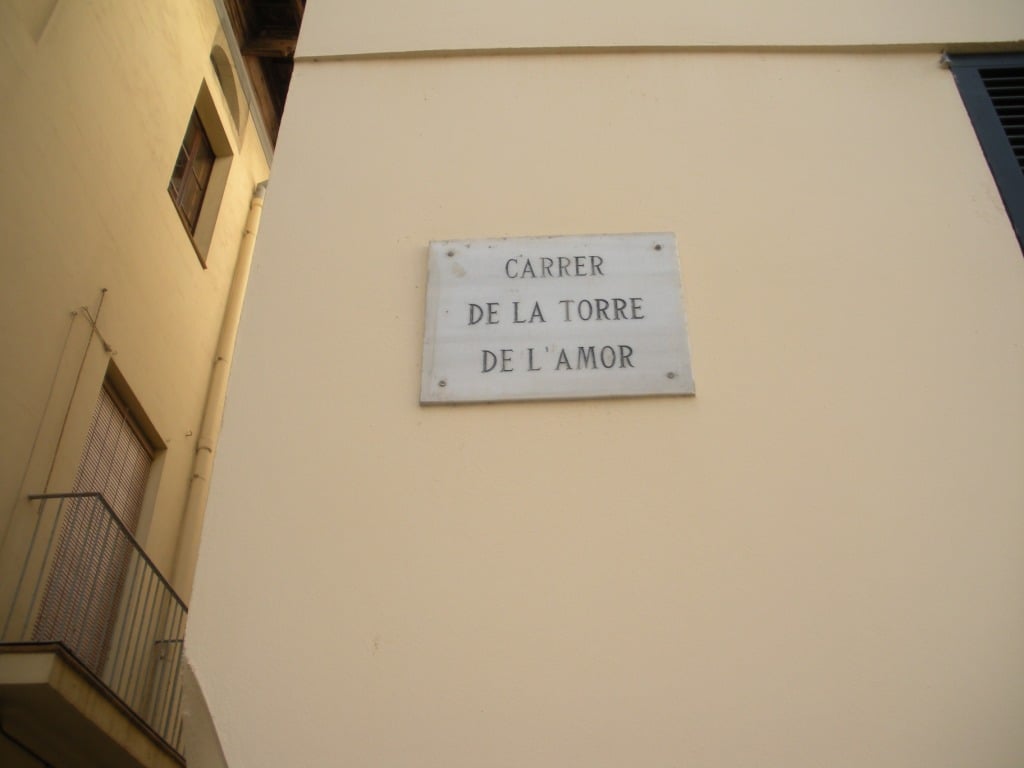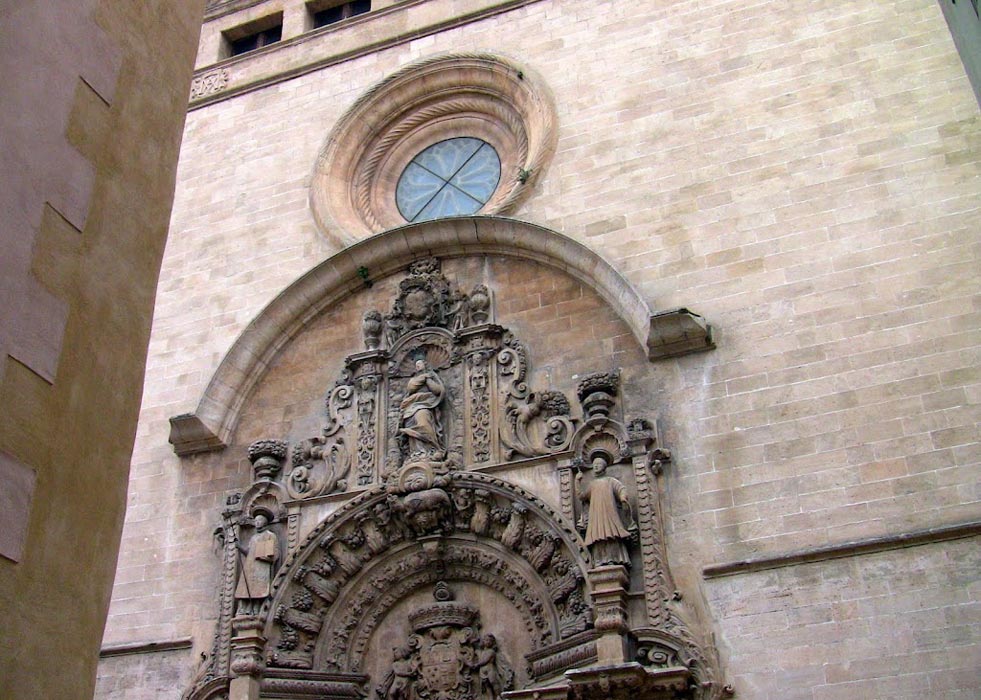After the slaughter in 1391 of over four thousand Jews at the hands of Sevillians driven on by the Archdeacon of Écija, there were barely any Jews left in Seville. The synagogue gradually stopped being used, and after the expulsion of the Jews from Spain ordered by the Catholic Monarchs, the synagogue was converted into a Christian church under the dedication of Santa Cruz. The architecture of this temple rested on four unequal columns. With the destruction of the temple the Church of Santa Cruz ended up setting up on Mateos Gago street and the columns were moved to the Jardín de la Aclimatación, near the Delicias gardens. This site was bought by Antonio de Orléans, the Duke of Montpensier, to annex it to the gardens of the Palace of San Telmo After the purchase in 1926 of part of the palace gardens to construct pavilions of the Iberoamerican Exhibition of 1929, La Rábida was opened and the current wall of the gardens was put up. In this way the columns were framed in the Access nearest the Chile Pavilion of the current San Telmo Gardens.
Archives: Directory listings
Directory listings
Jewish Interpretation Center of Sevilla
The Seville Jewish Quarter Visitors Centre offers visitors an exhibition about the Jews who lived in the quarter and the changes which took place from the Middle Ages up to the present day. It also talks about about the Jews who lived here and who had to abandon this land, about Jewish women and the Diaspora, and their culture, customs, songs, sayings and storytelling.
The Permanent Exhibition includes many manuscripts, some of which date from the times of the Inquisition, and the symbolic painting of the “Expulsion of the Jews from Seville”, with a number of different legends about famous figures and places of the Jewish Quarter of Seville.
Susona Street
Susone Street was previously called calle de la Muerte (death street) because of the skull of the Jewish Susona. Two tiles recall the legend on the wall of number 10 (one on each side of the corner). The first is the skull of Susona and the second recounts the legend with these words: “En estos lugares, antigua calle de la muerte, pusose la cabeza de la hermosa Suona ben Suzón, quien, por amor, a su padre traicionó y por ello atormentada dipúsolo en testamento.” It seems to be the case that the father belonged to a group of Jews which was preparing an uprising in 1481. The conspirators wanted to gain power in the city and endeavour, with the support of the Moslems, to take on the Christians of Seville. The conspiracy involved Diego Susón, banker and the ringleader; Pedro Fernández de Venedara, steward of the cathedral; Juan Fernández de Alboslaya, the attorney and Mayor, Adolfo de Triana and many more. The first of them had a daughter called Susona, who had a secret relationship with a Christian knight, whom she fell in love with. When she found that part of the plans of her father along with the other conspirators, was to kill the man she loved, she didn´t hesitate in informing him. The result was: the consouracy was disbanded and its ringleaders were arrested and sentenced to death. It is said that after her death, she asked in her will for her skull to be placed by way of punishment and example at the house where she lived of her own free will.
Juderia Street – Calle Juderia
Juderia street is one of the most charming streets in the Santa Cruz district. It has a very odd layout, starting by the Patio de Banderas at the former Citadel, passing under some houses. It crosses under one of the wall towers with an access at a bend, and it follows on the exterior of the citadel wall with a fountain and a headstone dedicated to Luis Cernuda. At this street we can see an arch and a tower which was part of the gate connecting the Citadel with the Jewish quarter.
Palma Jewish Cemetery
The town of Santa Eugenia is located 22 km from the capital Palma de Mallorca and possesses the only Jewish cemetery in Mallorca. It is situated between the towns of Santa Maria and Algaida and has about 1,500 inhabitants, known as Taujans. For centuries, Santa Eugenia was under the direction of Santa Maria, a nearby town. However, Santa Eugenia became independant in the nineteenth century.
Jafudà Cresques Monument
Perhaps here in at the Sapiencia plot was the site of the house and workshop of the famous cartographers Abraham Cresques and his son Jafudà Cresques, from a family whose members had attained lofty positions and had enjoyed a considerable reputation.The masterpiece by Cresques was the famous Atlas Catalán, a mapa mundi which Prince Juan gave as a gift to Charles V of France in 1381 and which today is on display at the Paris National Library
Gomera Temple Castle
Built on the fortified gate of the same name, the age-old way out of the city to Levante, over time the Temple Castle has been given many names, including the former Gomera Citadel. It was the headquarters of the Knights of the Templar who owned a good number of the houses in the Main Call and harboured the Jews until the Order disappeared in 1313.
The Tower of Love
Torre del Amor street brings to the present the dispute between two prominent Jews who resorted to the King´s arbitration. According to a document in the chancellery of Pedro the Ceremonious from 1379, this tower was built in 1365 by Moses Faquim owing to his love of another rich Jew who was his rival, Magaluf Natjar. He ostentatiously christened it the Love tower. And he boasted of it to the extent that he would even invite prominent Christians to go up the tower to spy on the house of his rival and the woman who was the object of his passion. Annoyed and humiliated the husband, Magaluf Natjar, lodged a complaint with the monarch. Pedro IV ordered the lowering by twelve palms of the pompous tower built by his rival Moses Faquim to spy at ease on the wife of the former who he was in love with
Main Synagogue – Monte Sion Church
Criança street gives out into the monumental Monte-Sión church whose rich gateway opens out onto another of the main arteries of the call. In this same year of 1299 in which he confirms the Jews´ rights to reside in this area, Jaime II authorises the construction of the main synagogue; however, the works did not start until 1310 and it was confiscated in 1315 .In 1348, King Pedro IV the Ceremonious granted the building or part of it to Bernat de Vallflor and gave him permission to build a baker´s, though the property would later go back into Jewish hands. In 1571, the chapel was knocked down and enlarged to build the current church.
Rua Palace (Casa de la Rua)
At the confluencia of Rúa street with Alfonso II el Casto square lies the house or palace of Rúa, from the 15th century, also known as the palace of Marqués de Santa Cruz del Marcenado and regarded as the oldest civil building in the city. Its solidity contrasts with Llanes House which stands by its side and which is dated 1740 as the residence of the Knight of the Order of St. James Menendo de Llanes-Campomanes. Opposite both constructions the statute La Regenta (wife of the Regent) displays its melancholy, a work by Mauro Álvarez from 1997, one of the numerous works of art occupying the city where the presence of the sculpture in the street has become one of its most genuine distinguishing features.
